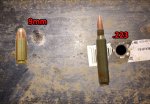I would like to point out that guns of the time period before they used brass shells would jam a bit less than half of the times they were fired and took about a full minute to reload. Sure there are the exceptions of multi barreled guns or different types of shot (blunderbuss, grenade rifles, etc.) but most soldiers still used bows and crossbows solely for the fact that they took a few seconds to reload and never jammed or exploded on them.
Barring the ridiculousness of forcing a character to spend a full 10 rounds reloading their single shot musket or spending double the amount of gold to have a firearm with two barrels or multiple pistols. An easier solution could be that the lower tiers of all armor aren't particularly useful at deflecting or stopping a bullet, but the higher tiers are made with techniques such as layering and the geometry to deflect or stop bullets from penetrating (Realism without ridiculousness). That way you don't make everyone throng to Dex or make heavy armor/bows and crossbows obsolete.
Guns although more expensive are more powerful in the early levels and then level out with bows and arrows (attack-roll wise) but would probably do more damage over their career.
How I would implement firearms a campaign
The damage type would either be piercing or bludgeoning whichever fits the setting
Long Rifles
-2d8 (4d8 if Critical)
-Range 200/800
-Long Rifles have the Heavy, Two handed, and Loading Property
-Price 100gp
Pistols
-1d10 (2d10 if Critical)
-Range 60/150
-Pistols have the Light and Loading Property
-Price 50gp
Blunderbuss
-2d10 (3d10 if Critical)
-Range 10/20
-Blunderbuss have the Heavy, Two handed, and Special properties
-Special: Firing a blunderbuss at an enemy within 5 feet does not impose disadvantage on the attack roll, however loading this weapon takes 10 bullets per shot
-Price 80gp
Bullets- the manufacturing of bullets takes 1 pound of lead per 10 bullets if gunsmithing tools are used
Price- 5gp per 20 bullets
Gunsmith's Tools- Similar to Smith's Tools but specifically pertaining to the making of ammunition and parts for firearms
Of course the prices of the firearms and bullets can be altered to fit the availability of technology and firearms. I simply prefer pseudo-modernity via magical technologies over natural scientific breakthroughs.
(Optional Rules that could be implemented for niche characters and setting)
Barring the ridiculousness of forcing a character to spend a full 10 rounds reloading their single shot musket or spending double the amount of gold to have a firearm with two barrels or multiple pistols. An easier solution could be that the lower tiers of all armor aren't particularly useful at deflecting or stopping a bullet, but the higher tiers are made with techniques such as layering and the geometry to deflect or stop bullets from penetrating (Realism without ridiculousness). That way you don't make everyone throng to Dex or make heavy armor/bows and crossbows obsolete.
Guns although more expensive are more powerful in the early levels and then level out with bows and arrows (attack-roll wise) but would probably do more damage over their career.
How I would implement firearms a campaign
The damage type would either be piercing or bludgeoning whichever fits the setting
Long Rifles
-2d8 (4d8 if Critical)
-Range 200/800
-Long Rifles have the Heavy, Two handed, and Loading Property
-Price 100gp
Pistols
-1d10 (2d10 if Critical)
-Range 60/150
-Pistols have the Light and Loading Property
-Price 50gp
Blunderbuss
-2d10 (3d10 if Critical)
-Range 10/20
-Blunderbuss have the Heavy, Two handed, and Special properties
-Special: Firing a blunderbuss at an enemy within 5 feet does not impose disadvantage on the attack roll, however loading this weapon takes 10 bullets per shot
-Price 80gp
Bullets- the manufacturing of bullets takes 1 pound of lead per 10 bullets if gunsmithing tools are used
Price- 5gp per 20 bullets
Gunsmith's Tools- Similar to Smith's Tools but specifically pertaining to the making of ammunition and parts for firearms
Of course the prices of the firearms and bullets can be altered to fit the availability of technology and firearms. I simply prefer pseudo-modernity via magical technologies over natural scientific breakthroughs.
(Optional Rules that could be implemented for niche characters and setting)
- Critical Fails render the the gun unfireable for 1d4 rounds.
- Firearms have the "Delayed Loading" trait and prevent using Reactions if the character decides to load the weapon.
- Firearms with multiple barrels cost x2.5 more than a single barreled firearm per barrel- does not include the blunderbuss they become really OP with more barrels
- Criticals sustained by firearms cause a -2 in AC for ranged attacks until the armor is repaired.
- Pistolero Feat.- Multiple Hand pistols can be fired in an action, as opposed to the normal firing of 2 pistols in a turn, 4 pistols can be fired if the user has sufficient pistols on his person.
Last edited:



